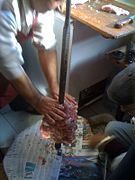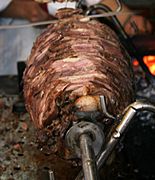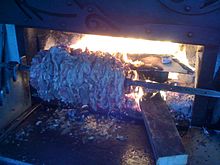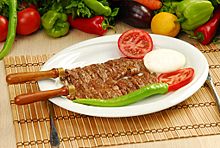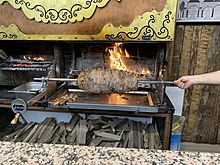Cağ kebabı facts for kids

Cağ kebabı, from Erzurum.
|
|
| Course | Kebab |
|---|---|
| Place of origin | Ottoman Empire |
| Region or state | Erzurum |
| Created by | Disputed, with various lawsuits. Goes back to 18th century. |
| Main ingredients | Marinated slices of lamb, tail fat, onion, sweet basil, black pepper and salt. |
Cağ kebabı is a special kind of kebab from Turkey. It's made from lamb meat cooked on a rotating spit, but unlike other kebabs, this one cooks horizontally! It comes from a place called Erzurum Province in Turkey.
Over time, this unique kebab has become a famous food in Erzurum. Many well-known chefs there, like Şakir Aktaş and Kemâl Koç, have restaurants that serve it. They all say their family invented it! While you can find Cağ kebabı in many Turkish cities, it's super popular in Erzurum. It's also becoming very well-liked in big cities like Istanbul and Ankara.
History of Cağ Kebabı
Long ago, in the 1700s, people in the Ottoman Empire wrote about a kebab cooked over a wood fire. This kebab had meat stacked horizontally. It was called "Cağ Kebabı" in the eastern part of Turkey, in the Erzurum area. Many people think this was an early version of the Doner kebab we know today. Now, this kebab is famous not just in Erzurum and Istanbul, but also in many countries in Europe.
What's in a Name?
The word "cağ" comes from the Armenian and Georgian languages. It means "spit" or "skewer." So, the kebab is named after the big spit that the meat is cooked on!
How Cağ Kebabı Is Made
Making Cağ kebabı takes time and care. First, thin slices of lamb meat are mixed with a lot of tail fat. This mix then sits in a special sauce for a whole day. The sauce is made from basil, black pepper, salt, and sliced onions. This helps the meat get lots of flavor.
After marinating, the meat slices are stacked thickly onto a long metal rod called a "cağ" (the spit). This spit is then placed over a fire. There's a clever machine that helps cook the meat perfectly. It can turn the spit, move it up and down, and even push the meat closer to the fire as it gets thinner. Only lamb meat is used for Cağ kebabı. When it's ready, pieces are cut off and served, often on a small skewer called a bico.


